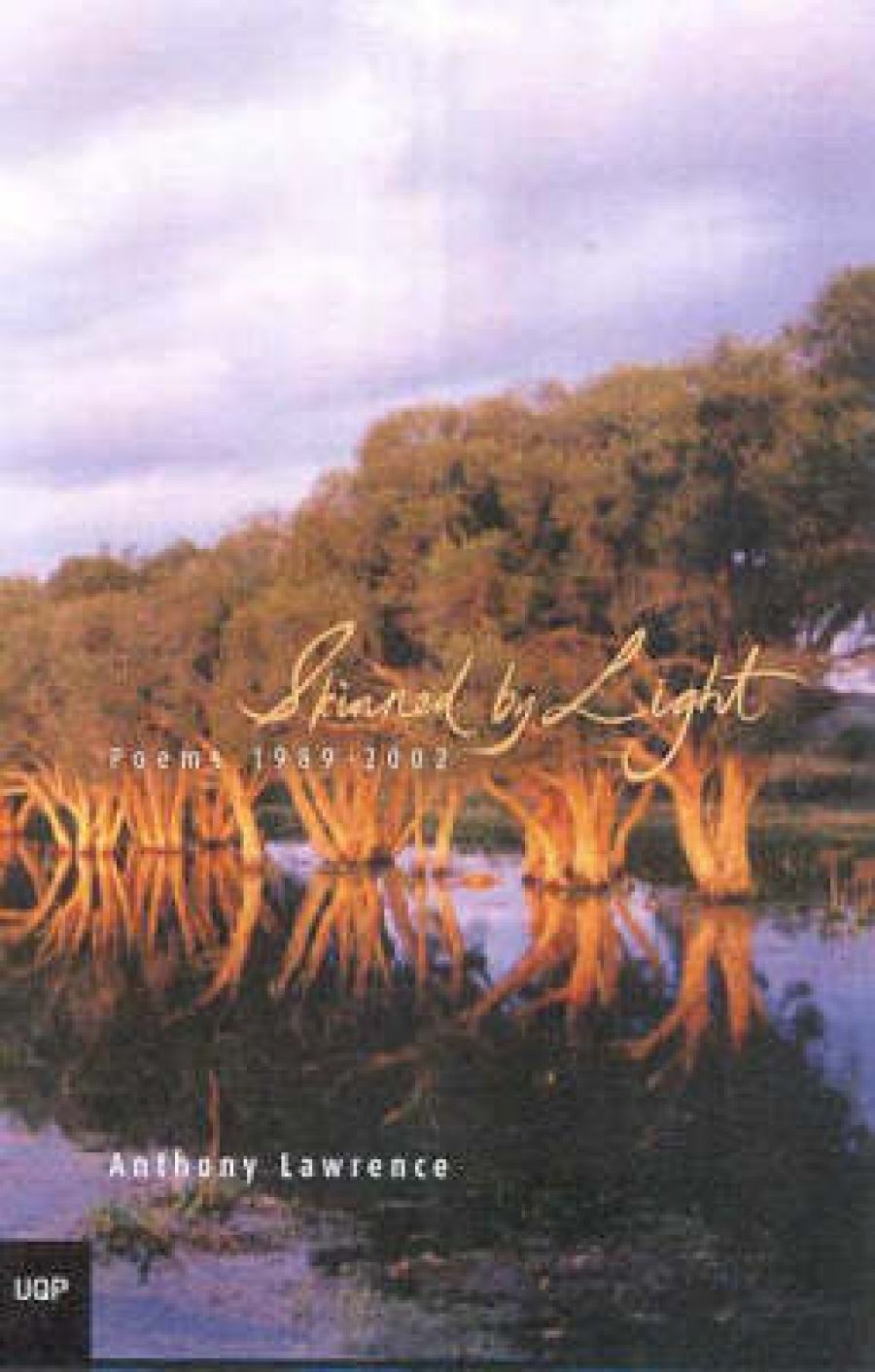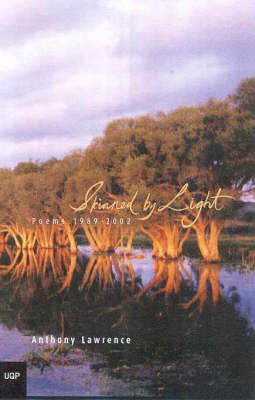
- Free Article: No
- Contents Category: Poetry
- Review Article: Yes
- Article Title: A Second Section
- Online Only: No
- Custom Highlight Text:
Anthony Lawrence’s latest collection of poetry, Skinned by Light: Poems 1989–2002, a revision of his New and Selected (1998), is a much tighter work than its predecessor – 121 as against 335 pages. While some may wonder why UQP has published another ‘Selected’ from Lawrence in the space of four years, the publication of his novel, In the Half Light (2000), justifies introducing Lawrence’s poetry to a wider readership.
- Book 1 Title: Skinned by Light
- Book 1 Subtitle: Poems 1989–2002
- Book 1 Biblio: UQP, $19.95 pb, 121 pp, 0702233439
- Book 1 Cover Small (400 x 600):

- Book 1 Cover (800 x 1200):

On first reading the collection, I was most excited by the new poems at the end. They continue Lawrence’s earlier preoccupations with narrative and personal involvement with nature, and yet there appears to have been a shift in Lawrence’s style. Many of these poems are mostly written in the third person. This has given Lawrence freedom to move within his customary detailed gaze. His voice has become less authoritative, allowing for more fluid landscapes, as in ‘Out from a Line of Fire’: ‘Out from a line of fire she has come / into these entanglements of coastal scrub / This largesse of flower, branchline / and shifting, abrasive light.’
Other new poems explore the metaphorical possibilities of birds and fire. In ‘Wind Sheer’, the narrative tensions within a relationship are linked to the transformative nature of weather: ‘In the east, the Aurora Australis / is lighting its fires: a flaring of blue curtains / printed with phantom town light.’ The assured tone of these new poems suggests that, on the whole, Lawrence has moved away from the romantic persona that inhabited many of his earlier poems. It is as if his poems have been allowed to speak for themselves and not be anchored to narrative detail. ‘The Water Table’ almost succeeds in this fashion, with its metaphor of the water beneath our feet linked to the love that barely surfaces in a relationship. Lawrence’s preference for narrative is announced early in the poem, ‘driven to the margins with the need to tell a story, mine and others’. Personally, I would have preferred such a desire for telling to undercut the poem, as in the evocative line, ‘under our feet the water table is black as blood without oxygen’.
Rereading the collection, I found links between Lawrence’s new poems and those from his previous collection. Nature as metaphor for processes of death and decay is present in poems such as ‘The Black and Orange Dead’, ‘Baiting Bush Rats’ and ‘Disaster Bay’, his homage to Frank O’Hara, where a dune buggy is given weighty symbolism. Is it essential for readers to know that Frank O’Hara was run over by a dune buggy in order to appreciate such symbolism? In ‘The Black and Orange Dead’, the symbolism of ladybirds at work on a piece of corn cob is unmistakable: the person spraying pyrethrum on grubs watches ‘The grubs rise into death / globes of milky fluid at the ends of their mouths’. Lawrence’s penchant for detail is marvellously evident in this poem where the ladybirds and leaves are juxtaposed with the memory of a concert in the Spanish town of Granada, which gives space to the minutiae of insect life.
Poems from Lawrence’s earlier collections are more closely linked to personal experience, love, travel and nature. That the themes of love and nature have become constants within Lawrence’s oeuvre indicates the range of his poetry. At times, I wondered if the influence of Robert Adamson and James Dickey was limiting the scope of his poetry. For Lawrence, love is often defined as either inaccessible or a regenerative force: ‘loving you / gave me things I’m only now beginning to name.’ Love is rarely imbued in the quotidian: ‘So when I say here that I love you // it’s because I’m not afraid anymore / to write without metaphors / that bury the heart’s intentions.’ While such honesty is admirable, it doesn’t guarantee the success of words on the page.
In an interview with John Kinsella on the web journal Thylazine, Lawrence described himself as a landscape poet who writes of ‘what’s imagined and what’s experienced’. Poems from Lawrence’s earlier collections seem to be more dependent on experience, and less on what is imagined. While development in a poet’s writing is essential – and Lawrence has grown as a poet – the earlier poems show him trawling through experience, at times elevating it into myth, as in ‘Tidal Dreaming’, the druggy ‘bad trip’ of ‘The Sleeping Car’, or the journey to Ireland in ‘Cold Wires of Rain’. The latter poem suggests a recurring theme in Lawrence’s poetry of travel, more specifically of departure. Throughout the collection, light appears as a fusing of imagination and landscape: ‘her body moves, / and light is what she leaves.’ Lawrence’s poems often revolve around, or end in, epiphanies, as in ‘Skinned by Light’:
But when sunset skinned the wall
of the ward, there appeared, between
bed posts propped like a pair
of cast iron fire dogs, flamelight
from a stone-bordered hearth.
The restlessness of birds, the looking outward to the natural world, and the voices of people ‘overspilling with urgency’ have all become trademark tensions of this poet, now destined for a wider audience.


Comments powered by CComment